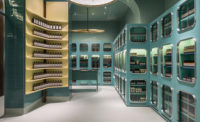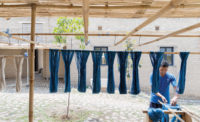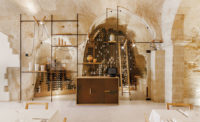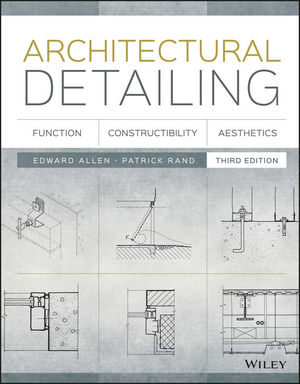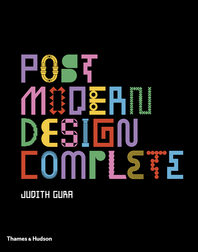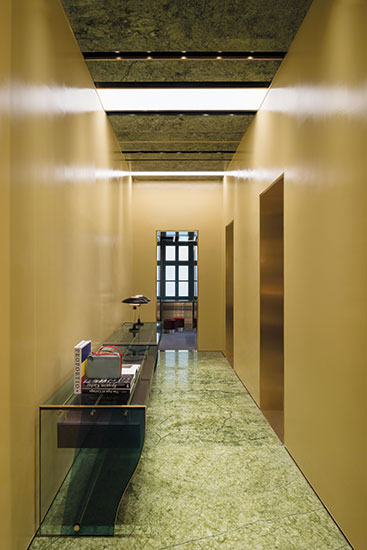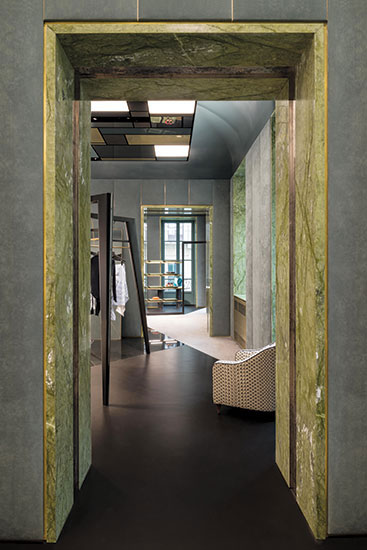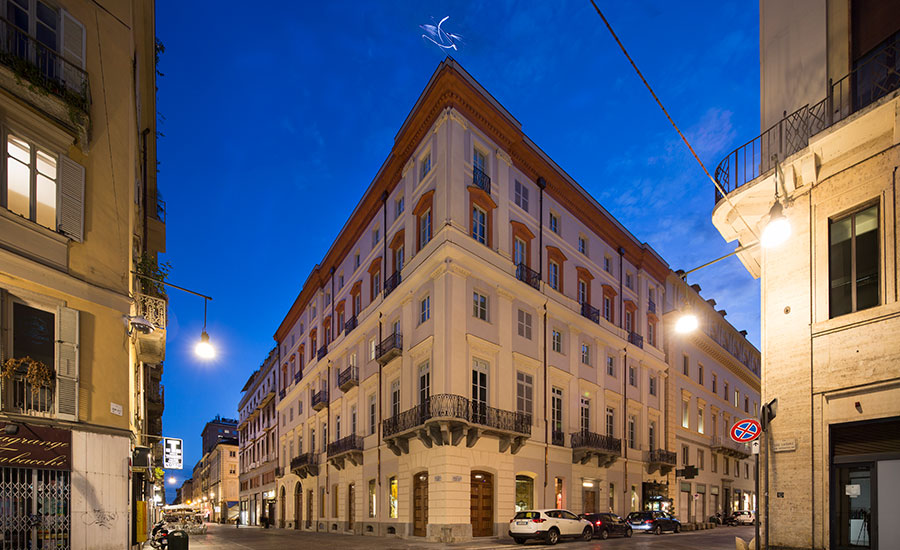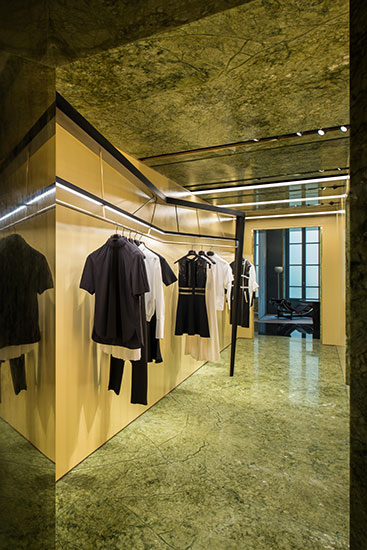Record Interiors 2016
Lagrange12 by Dimore Studio
Fashion Statement: A Milan-based design studio evokes a timeless aura of luxury for a clothing boutique.

A vintage velvet slipper chair and Vico Magistretti Lambda sconces from the Dimore Gallery greet shoppers at the portal to Lagrange12’s multibrand area.
Photo © Paola Pansini

In an adjacent corridor, Dimore Studio’s evocative scheme combines mid-20th- century Stilnovo table lamps with a custom display console.
Photo © Paola Pansini

Marble-clad doorways emphasize an enfilade on the second floor.
Photo © Paola Pansini

Taking cues from the work of Louise Bourgeois, Oscar Tuazon, and Jean Prouvé, Moran and Salci created sculptural iron clothing racks with polished-steel details and centered them in the rooms for easy circulation and sight lines.
Photo © Paola Pansini

Green satin was used for dressing room drapes and bronzed-mirror-clad steamer-trunk displays.
Photo © Paola Pansini

The retail complex occupies the first two levels of a luxury residential development in a restored and renovated 18th-century palazzo that had until recently housed offices for the municipal police.
Photo courtesy Lagrange12

An LC4 chaise longue, Stilnovo floor lamp, and Oueffice marble table (opposite) lend an urbane air to the renewed space.
Photo © Paola Pansini

Ground Floor Plan
Image courtesy Dimore Studio

Second-Floor Plan
Image courtesy Dimore Studio

The retail complex occupies the first two levels of a luxury residential development in a restored and renovated 18th-century palazzo, on a corner site, that had until recently housed offices for the municipal police.
Photo © Piero Ottaviano

The stairway to the second floor is clad in brushed stainless steel with softly burnished brass handrail. To light this interior space, Dimore Studio paired a custom floor-to-ceiling fixture at the landing with vintage sconces designed by Studio B.B.P.R. around the late 1960s.
Photo © Paola Pansini

Clad top and bottom with Ming Green marble from China, the apartment-like corridor at the top of the stairs features an iron clothing rack designed by Moran and Salci that was inspired by the works of Louise Bourgeois, Oscar Tuazon, and Jean Prouvé.
Photo © Paola Pansini

An audacious use of pattern fades into a subtle backdrop. On the floors, sections of carpet, resin, and black granite converge in large geometric swaths. Overhead, a series of Mondrianesque light fixtures—panel compositions made of polished and oxidized steel, brass, black-painted iron, colored glass, and backlit translucent acrylic—conceal down- lights and illuminate sales areas with both ambient and direct light.
Photo © Paola Pansini

Draped with green satin, the ladies dressing room is within a mirrored box that reflects the surrounding surfaces of Ming Green marble, brushed stainless steel and brass.
Photo © Paola Pansini

The men’s dressing room is lined with green satin draperies and has a luminous back-lit ceiling.
Photo © Paola Pansini

A settee in both the mens’ and women’s shoe areas is upholstered in a Rubelli textile—turned wrong side out by the designers to exploit its metallic threads. The black-painted iron displays feature under-lit, green-satin-wrapped shelves.
Photo © Paola Pansini
















Architects & Firms
Turin, Italy
Just one block from the frenetic activity of Turin’s Porta Nuova train station, the Via Giuseppe Luigi Lagrange (or Via Lagrange) is emblematic of the urban revival propelled by the winter Olympics held here in 2006. A traffic-free oasis, the rapidly gentrifying promenade is dotted with restored palazzi and museums, inviting gastronomic haunts, and such designer boutiques as Chanel, Miu Miu, and Prada. Among these, a new multibrand store, Lagrange12—so named for its address—offers more than immediately meets the eye from the street. Pristine single-label departments for Dior, Celine, St. Laurent, and Valentino—each designed by their in-house architectural teams—are located on the ground floor around the perimeter of this corner site, visible through the store’s windows and five entrances. What is not readily apparent to passersby, or those entering for the first time, is a luminous portal at the store’s core—behind the proprietary designer shops-within-the shop—which signals a unique retail experience.
Lustrous, gold-painted walls greet customers as they cross the brass-clad threshold that transports them into the store’s sensuous multibrand area, which comprises most of the 10,800-square-foot Lagrange12—about one and a half floors. Designed by the Milan-based Dimore Studio, it is devoted to a mix of men’s and women’s fashion from numerous upscale lines curated by store manager Loredana Panetta. Steering away from the minimalist decor of the dedicated designer shops, firm principals Britt Moran and Emiliano Salci developed a complex palette of colors, patterns, and materials that recalls more sumptuous eras yet underscores the seasonal collections with remarkably modern and understated results.
The retail complex occupies the first two levels of a luxury residential development in a restored and renovated 18th-century palazzo that had until recently housed offices for the municipal police. The space, which was gutted and apportioned by the client and construction team, reflects the historic six-story structure’s roots, with elegant daylit suites of rooms on each floor, some with vaulted ceilings. An enfilade on the second level reinforces the aura of a stately home.
The layout inspired Moran and Salci, who derived the name of their 13-year-old firm from the Italian word “dimora,” a dwelling or aging aristocratic villa. “But we don’t reproduce historical elements,” says Moran. “Rather, we try to recreate what in our imaginations is that historical moment.” The partners devised a scheme that exploits the interior’s gracious proportions, integrating decorative elements with the architecture to maintain a variety of apartment-like spaces—intimate, transitional, and spacious. As a departure from the building’s neoclassical shell, they drew from Art Deco motifs to create an atmosphere that reflects the passage of time.
With a near-baroque opulence, the designers emphasized deep jambs at the doors and windows, as well as corridor floors and ceilings, by cladding them with honed Ming Green marble edged by strips of brass. This softly-burnished metal reappears in the form of a balustrade that runs alongside a brushed stainless-steel stair and throughout the comfortably appointed rooms as perforated grills under windows (concealing HVAC equipment), on custom light fixtures, and between tufted wall panels of moss-green faux suede.
In less assured hands this rich layering would be excessive. But Moran and Salci—known for the fusion of art, fashion, and architecture in their work—demonstrate a restraint that never overpowers the merchandise. According to Salci, “by using bold, often matte colors, the palette becomes quite neutral.” Dark blue-green ceilings, for instance, offset the numerous green surface treatments.
An audacious use of pattern, too, fades into a surprisingly subtle backdrop for the sculptural iron clothing racks and bronzed mirror-clad trunk displays designed by Moran and Salci. On the floors, sections of low-pile carpet, resin, and black granite converge in large geometric swaths. Overhead, a series of Mondrianesque light fixtures—panel compositions made of polished and oxidized steel, brass, black-painted iron, colored glass, and backlit translucent acrylic—conceal downlights and illuminate sales areas with both ambient and direct light. The designers, who also own a gallery of period and contemporary furnishings, further augment the residential ambience with such select pieces as a vintage LC4 chaise longue by Le Corbusier, Pierre Jeanneret, and Charlotte Perriand. A visit to Lagrange12, says manager Panetta, is like being a guest at “a villa.”
Working largely with local artisans, Dimore Studio has crafted an evocative space that is both timely and timeless
PeopleInterior Design Firm: Dimore Studio, Via Solferino 11, Milan 20121, Italy (+39 02 36 53 70 88)
Personnel in firm who should receive special credit: Britt Moran, Emiliano Salci — partners in charge
Architect: Building Group (building restoration)
Engineer: Building Group
General contractor: Fabbri Services
Photographer: Paola Pansini
Client: G&B Negozio
Size: 10,800 square feet
Completion date: May 2016
|
ProductsTextiles Alcantara (first floor wall cladding panels); Rubelli (sofa upholstery); Dedar (changing room curtains and trunk display interior); Dedar (fabric for Azucena poufs); Kvadrat (ground floor wall cladding panels) Historical Items from Dimore Gallery Ground Floor Wall sconces ‘Lambda’ by Vico Magistretti Wall sconces ‘Euterpe’ by BBPR Floor lamps by Stilnovo Table lamps by Stilnovo Ceiling lamps (at entrance) by Stilnovo Armchairs by Paolo Buffa Historical Items from Dimore Gallery First Floor Original LC4 chaise longue by Le Corbusier, Charlotte Perriand and Pierre Jeanneret Gio Ponti armchair Floor lamps by Stilnovo CONTEMPORARY ITEMS FROM DIMORE GALLERY: Marble tables by Oeuffice CONTEMPORARY ITEMS FROM AZUCENA Cilindro poufs by Azucena |


